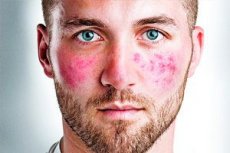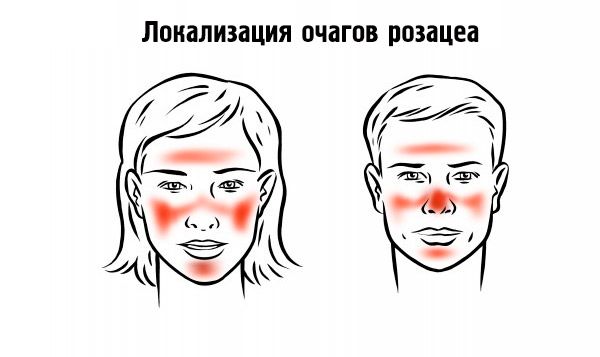Pink acne
Last reviewed: 23.04.2024

All iLive content is medically reviewed or fact checked to ensure as much factual accuracy as possible.
We have strict sourcing guidelines and only link to reputable media sites, academic research institutions and, whenever possible, medically peer reviewed studies. Note that the numbers in parentheses ([1], [2], etc.) are clickable links to these studies.
If you feel that any of our content is inaccurate, out-of-date, or otherwise questionable, please select it and press Ctrl + Enter.

Pink acne (synonyms: acne rosacea, rosacea, redheads) is a chronic disease of the sebaceous glands and hair follicles of the facial skin in combination with the increased sensitivity of the capillaries of the dermis to heat.
Causes of the rosacea
It is believed that rosacea is an angioneurosis in the zone of innervation of the trigeminal nerve caused by various factors: constitutional angiopathy, neurovegetative disorders, emotional stress, violation of hormonal balance, dysfunction of the digestive tract, fecal infection.
Pink acne develops as a result of angiopathy and inflammatory reaction in the skin of the face under the provocative influence of a complex of various factors: endocrine disorders, liver diseases, gastrointestinal tract, vegetative dystonia, alcohol abuse, etc. They occur mainly after 30 years. Can contribute to the development of the process, especially pustulysis, acne permeate due to a cell-mediated immune response. Clinically manifested stagnant erythema, telangnectasia and disseminated papular-pustular eruptions. In some cases, rashes may be on other parts of the body (on the chest, back).
Some authors consider as a form of pink acne rhinophyma, which is characterized by the development and areas of the nose, less often the chin and other areas of the linden of tuberous, lobed knots, separated by furrows, sometimes reaching gigantic proportions. Distinguish the following stages of the disease: erythematous, papular, pustular and infiltrative-productive (rhinophyma). This division, however, is arbitrary, since usually patients have a combination of different morphological elements. Eye damage (blepharitis, conjunctivitis, iritis, keratitis) can be observed.
Rosacea similar changes in the facial skin are observed in so-called perioral dermatitis, which is probably one of the forms of rosacea or seborrhea, developing mainly with long-term use of fluorinated corticosteroid ointments.
The majority of patients in the lesion focus often find the presence of tick "iron".
Pathogenesis
With erythematous papular and papulo-pustular stages, focal lymphocytic infiltrates in the dermis are present in the presence of reticular and mast cells, giant Lanhans cells, as well as hyperplasia of the sebaceous glands.
Pathomorphology
In the erythematous stage of the process, changes predominate in the vascular apparatus of the skin, then in the collagen substance. Vessels, especially the veins, are usually sharply expanded, a loose fibrous connective tissue grows around their walls, without a pronounced inflammatory component, which indicates the presence of vasomotor disorders. Collagen fibers are loosened as a result of edema, hair follicles somewhat atrophic with horny plugs in their mouths.
The papular stage is characterized by an inflammatory response in the form of a widespread or focal infiltrate of a lymphohistiocyte character with the presence of sometimes giant Pirogov-Langhans cells or foreign bodies.
In the pustular stage, changes in blood vessels and the follicular apparatus, a more intense inflammatory reaction, are manifested in massive infiltration of lymphocytes with an admixture of a large number of neutrophilic granulocytes, with the formation of pustules. Horny cysts, which are a consequence of atrophic changes in the follicular apparatus, as well as the destruction of collagen are more frequent than in the first two stages.
With the rhinophyma, a pronounced proliferative component is noted, characterized by the proliferation of connective tissue leading to thickening of the dermis, obliteration of the vessels, which further disturbs the microcirculation in these areas. Sometimes inflammatory infiltrates with an admixture of neutrophilic granulocytes are found.
Histogenesis
On the pathogenesis of rosacea, there are different points of view. More common is the opinion about the important role of various neurotic disorders and vegetative dystonia, as well as stressful influences. The role of hereditary predisposition is not ruled out. There were works, indicating the role of immune disorders. According to some authors, there is a deposition of IgM and / or complement in the dermo-epidermal junction and in dermal collagen. In the blood serum, IgM-type circulating antibodies were detected. Immunomorphological analysis of infiltrate cells showed that the infiltrate consists mainly of LEU-1-reactive T cells with a predominant content of KEU-3a-antibody-positive T helper cells, while LEU-2a-cynpeccopic-cytotoxic T cells were rare . These cells infiltrate the follicular epithelium and the epidermis. In cases where demodex is present, most T cells are found in infiltrates around the mite and are T helper cells. The predominance of similar T cells in the infiltrate in association with demodex indicates a violation of cellular immunity.
Symptoms of the rosacea
The disease begins with diffuse facial erythema and telangiectasia. Against this background, in the presence of seborrheic phenomena, follicular nodules and scattered pustules arise. Papules and nodes are round and dome-shaped.
Elements are localized randomly on the skin of the nose, cheeks, chin, less often - neck, chest, back, scalp.

Subjective sensations are insignificant: patients are concerned about cosmetic defect and external similarity with patients with alcoholism. During the tide, reddening of the face with a feeling of heat is noted. With prolonged course of the process and absence of treatment, rhinophyma (pineal nose), metophima (puffy thickening of the forehead skin), blepharophyma (thickening of the eyelids due to hyperplasia of the sebaceous glands), otofim (growth of the earlobe in the form of cauliflower), gnathofima (thickening of the chin skin ).
As a result of chronic blepharitis, conjunctivitis and episcleritis, reddening of the eyes is noted. Possible keratitis and corneal ulcer.
Stages
Distinguish the following stages of the disease:
- prodromal period - hot flashes;
- the first stage - the emergence of persistent erythema, telangiectasia;
- the second stage - the appearance against the background of persistent erythema and telangiectasis papules and small pustules;
- the third stage is the emergence of a dense net of telangiectasia, papules, pustules against the background of persistent saturated erythema; there are nodes and extensive infiltrates.
 [18]
[18]
What do need to examine?
How to examine?
Treatment of the rosacea
Complex treatment is carried out, including general and local medicines. With abundant pustular eruptions, antibiotics are prescribed (tetracycline 1-1.5 g / day in several doses, as the condition improves, the dose is gradually reduced to 250-500 mg once a day, or doxycycline 100 mg twice a day).
An important place is taken by vitamin therapy (A, C, PP, group B) as a general restorative and for increasing the resistance of capillaries. A good effect has trichopolum (metronidozole) 500 mg once a day for the first month, then 250 mg once a day for the next month. When torpid current is shown immunomodulatory therapy. In severe disease and no effect from the above, roaccutane (isotretinoin) is shown in 0.1 to 1 mg / kg of the patient's weight, depending on the clinic of the disease. In addition, depending on the degree of disturbance of the nervous system, sedatives and tranquilizers are prescribed. It is also necessary to treat somatic pathology.
Locally appoint 0.75% cream or trichopol-gel 2 times a day and antibiotics (clindomycin sulfate or erythromycin) in the form of a cream or ointment. If rosacea is accompanied by severe inflammation, corticosteroid ointments are recommended. Given that the mites "iron" support the inflammatory process, prescribe 20-30% sulfuric ointment, Demjanovich's method, Skinoren cream, etc.
In sunny weather, you should use photoprotective creams.
More information of the treatment
Drugs

